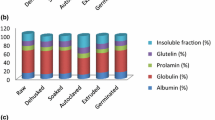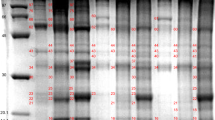Abstract
The effects of heat treatments on the proximate composition, energy content, and levels of some antinutritional factors in brown and marble-colored African yam bean (AYB) seed flours were investigated. In raw brown and marble-colored AYB seed flours; moisture content, dry matter, crude protein, crude fat, ash, total carbohydrate and caloric value did not differ significantly at the 5% level. Autoclaving and cooking slightly increased the moisture level. Crude protein, crude fat, and ash contents were decreased by autoclaving and were further decreased by cooking. The decrease was not, however, considerable for the AYB that is not eaten raw and whose full nutritional potential as a legume can be derived only when heat treated, as previous reports have indicated for legume seeds.The levels of the toxicants were generally higher in the raw brown AYB compared to the marble-colored, and were generally reduced by both autoclaving and cooking. In the most commonly available and consumed marble-colored AYB, autoclaving at 121 °C, 15 psi for 20 min decreased cyanogenic glycosides by 46%, oxalate by 48.9%, tannin by 15.0%, saponin by 14.8% and trypsin inhibitors by 61.3% while cooking for 3.5 hours in tap water decreased these toxic factors by 66.5%, 70.3%, 72.2%, 48.7%, and 86.0%, respectively.The results indicate that for raw samples, varietal difference did not significantly affect nutrient composition though the toxicants were generally higher in the brown AYB than the marble-colored. Autoclaving decreased both nutrient value and the level of toxicants in the two seed types; values were further reduced by cooking. Of the toxicants, trypsin inhibitor was found to be the most heat-labile and of the heat treatment methods, cooking to tenderness is recommendable.
Similar content being viewed by others
References
Hutchinson J, Dalziel JM (1958) Flora of West Tropical Africa. Vol. 7, Part 2 p. 564. London: Crown Agents for Overseas Government.
Ezueh MI (1977) Cultivation and utilization of minor legumes in Nigeria. Trop Grain Legume Bull 10: 28–34.
Evans IM, Boulter D (1974) Amino acid composition of seed meals of yam bean (Sphenostylis stenocarpa) and lima bean (Phaseolus lunatus). J Sci Food Agric 25(8): 919–922.
Ezueh MI (1984) African yam bean as a crop in Nigeria. World Crops 36(6): 199–200.
Applegarth A, Furata F, Lepkovsky S (1964) Response of the chicken pancreas to raw soyabean. Poult Sci 43: 733–737.
Schingoethe DJ, Tideman IJ, Uckert JR (1974) Studies in mice on the isolation and characterization of growth inhibitors from soyabeans. J Nutr 104: 1304–1309.
Owusu-Domfeh K (1967) Nutritive value of some Ghanaian feedstuffs. Unpublished M.Sc Thesis, University of Saskatchewan.
McGuinness EE, Morgan RJH, Wormsley KG (1984) Effects of Soyabean flour on the pancreas of rats. Envir Health Perspect 56: 205–210.
Sri Kantha S, Erdman Jr JW (1988) Effects of different heat treatments of winged bean seed flour on the nutritional status of rats. Nutr Rep Internat 38(2): 423–435.
Kakade ML, Evans RJ (1965a) Growth-inhibition of rats fed navy bean fractions. J Agric Food Chem 77: 450–452.
AOAC (1990) Official Methods of Analysis, 15th ed Arlington Virginia. Association of Official Analytical Chemists.
Kjeldahl J (1883) Determination of protein nitrogen in food products. Ency Food Sci: 439-441.
Onyeike EN, Ikuru, PR (1998) Preliminary investigation of proximate composition of heat processed cashew nut seed (Anacardium occidentale) flours. J Appl Sci Environ Manage 1: 27–30.
Munro A, Bassir O (1969) Oxalates in Nigerian vegetables. West Afr J Biol Appl Chem 12(1): 14–18.
Burns RB (1971) Methods of estimation of tannin in the grain sorghum. Agronomy J 63: 511.
Smith C, Megen WV, Twaalfhoven L, Hitchcock C (1980) The determination of trypsin inhibitor levels in foodstuffs. J Sci Food Agric 31: 321–350.
Onyeike EN, Abbey BW, Anosike EO (1991) Kinetics of heat inactivation of trypsin inhibitors from the African yam bean (Sphenostylis stenocarpa). Food chem 40: 9–23.
Duncan BO (1955) Multiple range and multiple F-Tests. Biometrics 11: 1–42.
Oyenuga VA (1968) Nigeria's Foods and Feeding Stuffs, 3rd ed Ibadan, Ibadan University Press. pp 79–83.
Bingham S (1978) Nutrition: A Consumer's Guide to Good Eating. Transworld publishers London, pp 123–127.
FAO (1973) Energy and Protein Requirement. World Health Organisation, Geneva Switzerland.
Oke OL (1969) Role of hydrocyanic acid in nutrition. World Rev Nutr Dietet 11: 170.
Osisiogu UN, Uzor JO, Ugochukwu EN (1974) The irritant effect of cocoyams. Planta Medica 26: 166–169.
Dresbach RH (1980) Handbook of Poisoning, Prevention, Diagnosis and Treatment. Lange Medical Publication LA California, pp 488–504.
Martin-Tanguy J, Guillaume J, Kosso A (1977) Condensed tannin in horse bean seeds: chemical, structure and apparent effect on poultry. J Sci Food Agric 28: 757–765.
Abbey BW, Neale RJ, Norton G (1979) Nutritional effects of field bean (Vicia faba) proteinase inhibitors fed to rats. Brit J Nutr 47: 31–38.
Swain T. (1979) Digestibility reducing effect of tannins. Recent Adv Phytochem 12: 617–619.
Newberne PM (1980) Naturally-ocurring food borne toxicants In Goodhart RS, Schills ME (eds), Modern Nutrition in Health and Disease. Philadelphia, pp 463-496.
Laskowski M, Laskowski Jr M (1954a) Naturally occurring trypsin inhibitors. In Boyer PD (ed.), The Enzymes. vol 11, Academic Press New York, pp 376–473.
Feeney RE, Allison RG (1969) Evolutionary Biochemistry of Proteins Homologous and Analogous Proteins from Avian Egg Whites, Blood Sera, Milk and Other Substances, Wiley Interscience, New York.
Liener IE (1962) Toxic factors in edible legumes and their elimination. Am J Clin Nutr 11: 287–298.
Author information
Authors and Affiliations
Rights and permissions
About this article
Cite this article
Onyeike, E.N., Omubo-Dede, T.T. Effect of heat treatment on the proximate composition, energy values, and levels of some toxicants in African yam bean (Sphenostylis stenocarpa) seed varieties. Plant Foods Hum Nutr 57, 223–231 (2002). https://doi.org/10.1023/A:1021833516234
Issue Date:
DOI: https://doi.org/10.1023/A:1021833516234




